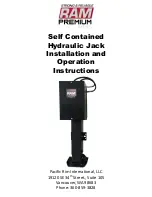
!WARNING
●Read and understand the operating instructions before use.
●The vehicle must be properly supported and blocked before starting repairs.
●Use a transmission jack of the proper size and capacity to handle the anticipated load. This
jack is rated for a maxim
um load 2.000 lb. Do not overload beyond the jack’s rated capacity.
Overloading may cause damage to or failure of the jack.
●Keep hands, fingers, and arms away from moving parts of the jack at all times.
●Because the load with the safety chain before lowering, or moving the load.
●Lower the lot slowly and avoid sudden starts or stops that may cause the load to shift.
●This jack is designed for use only on hard, level surfaces capable of sustaining the load. Use
on other than hard, level surfaces can result in jack instability and possible loss of load.
●Do not use the transmission jack if under the influence of alcohol or drugs.
●This transmission jack is designed and intended for use by properly trained and experienced
personnel only. If you are not familiar with the proper and safe operation of a transmission
jack. Do not use until proper training and knowledge have been obtained.
●The use of this jack is limited to the removal. Installation, and transportation in the lowered
position of transmissions and differentials.
●Failure to comply with all of those warning may cause loss of load. Damage to the jack
and/or failure of jack resulting in serious injury and/or property damage.
Operation
All numbers in parentless refer to the index number from the parts breakdown.
CAUTION :
Remove the plastic cap on the valve(9) before operating the jack. Failure to
comply may cause improper operation.
1. Move the jack into position.
2. Turn the pressure valve knob (6) clockwise fully to close the pressure valve.
3. Move the pump lever (11) up and down to raise the worktable.
4. Adjust the table travel screw (29) and the slant angle screw (25) to align with the shape of
the transmission.
5. Adjust the jaws and the chain to secure the transmission on the table.
6. Remove the transmission from the vehicle.
7. Turn the pressure valve knob (6) counter-clockwise slowly to lower the table. Lower the
table slowly.
8. Reverse this procedure when mounting the transmission.
Maintenance
The hydraulic cylinder assembly contains hydraulic fluid that must be kept at approximately
80% of full at all times for proper operation. To check the level and to fill :
1. Turn the pressure valve knob (6) counter-clockwise.
2. Allow the table lower completely.
3. Remove the air valve (9) by unscrewing.
4. Make a visual imspection inside the air valve opening. The hydraulic fluid must be
approximately 80% of the capacity of the hydraulic cylinder.
5. Fill with clean hydraulic fluid only.
6. Replace the air valve.






















